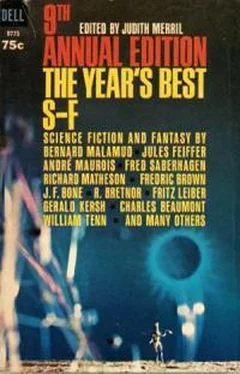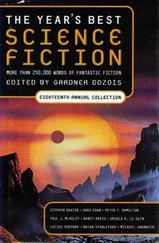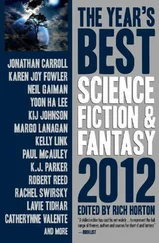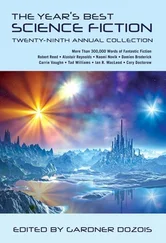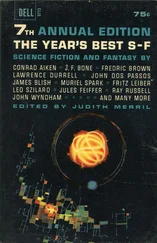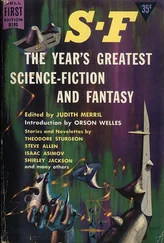The Year's Best Science Fiction 9
Здесь есть возможность читать онлайн «The Year's Best Science Fiction 9» весь текст электронной книги совершенно бесплатно (целиком полную версию без сокращений). В некоторых случаях можно слушать аудио, скачать через торрент в формате fb2 и присутствует краткое содержание. Год выпуска: 1965, Издательство: Dell, Жанр: Фантастика и фэнтези, на английском языке. Описание произведения, (предисловие) а так же отзывы посетителей доступны на портале библиотеки ЛибКат.
- Название:The Year's Best Science Fiction 9
- Автор:
- Издательство:Dell
- Жанр:
- Год:1965
- ISBN:нет данных
- Рейтинг книги:5 / 5. Голосов: 1
-
Избранное:Добавить в избранное
- Отзывы:
-
Ваша оценка:
- 100
- 1
- 2
- 3
- 4
- 5
The Year's Best Science Fiction 9: краткое содержание, описание и аннотация
Предлагаем к чтению аннотацию, описание, краткое содержание или предисловие (зависит от того, что написал сам автор книги «The Year's Best Science Fiction 9»). Если вы не нашли необходимую информацию о книге — напишите в комментариях, мы постараемся отыскать её.
The Year's Best Science Fiction 9 — читать онлайн бесплатно полную книгу (весь текст) целиком
Ниже представлен текст книги, разбитый по страницам. Система сохранения места последней прочитанной страницы, позволяет с удобством читать онлайн бесплатно книгу «The Year's Best Science Fiction 9», без необходимости каждый раз заново искать на чём Вы остановились. Поставьте закладку, и сможете в любой момент перейти на страницу, на которой закончили чтение.
Интервал:
Закладка:
Despite hopeful announcements that the wave was slowing, had virtually stopped after inundating Oklahoma City, was being swallowed up in the desert near Amarillo, the wall of water continued its advance. For the land was still sinking, and the floods were constantly replenished from the Gulf. Schwartzberg and his geologists advised the utmost haste in evacuating the entire area between Colorado and Missouri, from Texas to North Dakota.
Lubbock, Texas, went under. On a curling reflex the tidal wave blotted out Sweetwater and Big Spring. The Texas panhandle disappeared in one great swirl.
Whirlpools opened. A great welter of smashed wood and human debris was sucked under, vomited up and pounded to pieces. Gulf water crashed on the cliffs of New Mexico and fell back on itself in foam. Would-be rescuers on the cliffs along what had been the west bank of the Pecos River afterward recalled the hiss and scream like tearing silk as the water broke furiously on the newly exposed rock. It was the most terrible sound they had ever heard.
“We couldn’t hear any shouts, of course, not that far away and with all the noise,” said Dan Weaver, Mayor of Carlsbad. “But we knew there were people down there. When the water hit the cliffs, it was like a collision between two solid bodies. We couldn’t see for over an hour, because of the spray.”
Salt spray. The ocean had come to New Mexico.
The cliffs proved to be the only effective barrier against the westward march of the water, which turned north, gouging out lumps of rock and tumbling down blocks of earth onto its own back. In places scoops of granite came out like ice cream. The present fishing town of Rockport, Colorado, is built on a harbor created in such a way.
The water had found its farthest westering. But still it poured north along the line of the original Fault. Irresistible fingers closed on Sterling, Colorado, on Sidney, Nebraska, on Hot Springs, South Dakota. The entire tier of states settled, from south to north, down to its eventual place of stability one thousand feet below the level of the new sea.
Memphis was by now a seaport. The Ozarks, islands in a mad sea, formed precarious havens for half-drowned humanity. Waves bit off a corner of Missouri, flung themselves on Wichita. Topeka, Lawrence and Belleville were the last Kansas towns to disappear. The Governor of Kansas went down with his State.
Daniel Bernd of Lincoln, Nebraska, was washed up half-drowned in a cove of the Wyoming cliffs, having been sucked from one end of vanished Nebraska to the other. Similar hairbreadth escapes were recounted on radio and television.
Virtually the only people saved out of the entire population of Pierre, South Dakota, were the six members of the Creeth family. Plucky Timothy Creeth carried and dragged his aged parents to the loft of their barn on the outskirts of town. His brother Geoffrey brought along the younger children and what provisions they could find—”Mostly a ham and about half a ton of vanilla cookies,” he explained to his eventual rescuers. The barn, luckily collapsing in the vibration as the waves bore down on them, became an ark in which they rode out the disaster.
“We must of played cards for four days straight,” recalled genial Mrs. Creeth when she afterwards appeared on a popular television spectacular. Her rural good humor undamaged by an ordeal few women can ever have been called on to face, she added, “We sure wondered why flushes never came out right. Jimanettly, we’d left the king of hearts behind, in the rush!”
But such lightheartedness and such happy endings were by no means typical. The world could only watch aghast as the water raced north under the shadow of the cliffs which occasionally crumbled, roaring, into the roaring waves. Day by day the relentless rush swallowed what had been dusty farmland, cities and towns.
Some people were saved by the helicopters which flew mercy missions just ahead of the advancing waters. Some found safety in the peaks of western Nebraska and the Dakotas. But when the waters came to rest along what is roughly the present shoreline of our inland sea, it was estimated that over fourteen million people had lost their lives.
No one could even estimate the damage to property; almost the entirety of eight states, and portions of twelve others, had simply vanished from the heart of the North American continent forever.
It was in such a cataclysmic birth that the now-peaceful Nebraska Sea came to America.
Today, nearly one hundred years after the unprecedented —and happily unrepeated—disaster, it is hard to remember the terror and despair of those weeks in October and November, 1973. It is inconceivable to think of the United States without its beautiful and economically essential curve of interior ocean. Two-thirds as long as the Mediterranean, it graduates from the warm waters of the Gulf of Mexico through the equally blue waves of the Mississippi Bight, becoming cooler and greener north and west of the pleasant fishing isles of the Ozark Archipelago, finally shading into the gray-green chop of the Gulf of Dakota.
What would the United States have become without the 5,600-mile coastline of our inland sea? It is only within the last twenty years that any but the topmost layer of water has cleared sufficiently to permit a really extensive fishing industry. Mud still held in suspension by the restless waves will not precipitate fully even in our lifetimes. Even so, the commercial fisheries of Missouri and Wyoming contribute no small part to the nation’s economy.
Who can imagine what the Middle West must have been like before the amelioration of climate brought about by the proximity of a warm sea? The now-temperate state of Minnesota (to say nothing of the submerged Dakotas) must have been Siberian. From contemporary accounts Missouri, our second California, was unbelievably muggy, almost uninhabitable during the summer months. Our climate today, from Ohio and North Carolina to the rich fields of New Mexico and the orchards of Montana, is directly ameliorated by the marine heart of the continent.
Who today could imagine the United States without the majestic sea cliffs in stately parade from New Mexico to Montana? The beaches of Wyoming, the American Riviera, where fruit trees grow almost to the water’s edge? Or incredible Colorado, where the morning skier is the afternoon bather, thanks to the monorail connecting the highest peaks with the glistening white beaches?
Of course there have been losses to balance slightly these strong gains. The Mississippi was, before 1973, one of the great rivers of the world. Taken together with its main tributary, the Missouri, it vied favorably with such giant systems as the Amazon and the Ganges. Now, ending as it does at Memphis and drawing its water chiefly from the Appalachian Mountains, it is only a slight remnant of what it was. And though the Nebraska Sea today carries many times the tonnage of shipping in its ceaseless traffic, we have lost the old romance of river shipping. We may only guess what it was like when we look upon the Ohio and the truncated Mississippi.
And transcontinental shipping is somewhat more difficult, with trucks and the freight-railroads obliged to take the sea ferries across the Nebraska Sea. We shall never know what the United States was like with its numerous coast-to-coast highways busy with trucks and private cars. Still, the ferry ride is certainly a welcome break after days of driving, and for those who wish a glimpse of what it must have been like, there is always the Cross-Canada Throughway and the magnificent U. S. Highway 73 looping north through Minnesota and passing through the giant port of Alexis, North Dakota, shipping center for the wheat of Manitoba and crossroad of a nation.
The political situation has long been a thorny problem. Only tattered remnants of the eight submerged states remained after the flood, but none of them wanted to surrender its autonomy. The tiny fringe of Kansas seemed, for a time, ready to merge with contiguous Missouri, but following the lead of the Arkansas Forever faction, the remaining population decided to retain political integrity. This has resulted in the continuing anomaly of the seven “fringe states” represented in Congress by the usual two senators each, though the largest of them is barely the size of Connecticut and all are economically indistinguishable from their neighboring states.
Читать дальшеИнтервал:
Закладка:
Похожие книги на «The Year's Best Science Fiction 9»
Представляем Вашему вниманию похожие книги на «The Year's Best Science Fiction 9» списком для выбора. Мы отобрали схожую по названию и смыслу литературу в надежде предоставить читателям больше вариантов отыскать новые, интересные, ещё непрочитанные произведения.
Обсуждение, отзывы о книге «The Year's Best Science Fiction 9» и просто собственные мнения читателей. Оставьте ваши комментарии, напишите, что Вы думаете о произведении, его смысле или главных героях. Укажите что конкретно понравилось, а что нет, и почему Вы так считаете.
